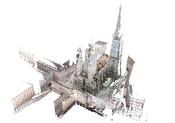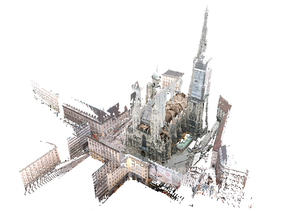Information
- Publication Type: PhD-Thesis
- Workgroup(s)/Project(s):
- Date: 2014
- Date (Start): December 2006
- Date (End): July 2014
- 1st Reviewer: Michael Wimmer
- 2nd Reviewer: Reinhard Klein
- Rigorosum: 18. July 2014
- First Supervisor: Michael Wimmer
- Keywords: point-based rendering, out-of-core rendering, data structures, complexity analysis
Abstract
During the last decade the increased use of laser range-scanners for sampling the environment has led to gigantic point cloud data sets. Due to the size of such data sets, tasks like viewing, editing, or presenting the data have become a challenge per se, as the point data is too large to fit completely into the main memory of a customary computer system. In order to accomplish these tasks and enable the interaction with gigantic point clouds on consumer grade computer systems, this thesis presents novel methods and data structures for efficiently dealing with point cloud data sets consisting of more than 109 point samples.To be able to access point samples fast that are stored on disk or in memory, they have to be spatially ordered, and for this a data structure is proposed which organizes the points samples in a level-of-detail hierarchy. Point samples stored in this hierarchy cannot only be rendered fast, but can also be edited, for example existing points can be deleted from the hierarchy or new points can be inserted. Furthermore, the data structure is memory efficient, as it only uses the point samples from the original data set. Therefore, the memory consumption of the point samples on disk, when stored in this data structure, is comparable to the original data set. A second data structure is proposed for selecting points. This data structure describes a volume inside which point samples are considered to be selected, and this has the advantage that the information about a selection does not have to be stored at the point samples.
In addition to these two previously mentioned data structures, which represent novel contributions for point data visualization and manipulation, methods for supporting the presentation of point data sets are proposed. With these methods the user experience can be enhanced when navigating through the data. One possibility to do this is by using regional meshes that employ an out-of-core texturing method to show details in the mesoscopic scale on the surface of sampled objects, and which are displayed together with point clouds. Another possibility to increase the user experience is to use graphs in 3D space, which helps users to orient themselves inside point cloud models of large sites, where otherwise it would be difficult to find the places of interest. Furthermore, the quality of the displayed point cloud models can be increased by using a point size heuristics that can mimic a closed surface in areas that would otherwise appear undersampled, by utilizing the density of the rendered points in the different areas of the point cloud model.
Finally, the use of point cloud models as a tool for archaeological work is proposed. Since it becomes increasingly common to document archaeologically interesting monuments with laser scanners, the number application areas of the resulting point clouds is raising as well. These include, but are not limited to, new views of the monument that are impossible when studying the monument on-site, creating cuts and floor plans, or perform virtual anastylosis.
All these previously mentioned methods and data structures are implemented in a single software application that has been developed during the course of this thesis and can be used to interactively explore gigantic point clouds.
Additional Files and Images
Additional images and videos
 image:
Point model of the Wiener Stephansdom consisting of 460 million points
image:
Point model of the Wiener Stephansdom consisting of 460 million points
Additional files
Weblinks
No further information available.BibTeX
@phdthesis{scheiblauer-thesis,
title = "Interactions with Gigantic Point Clouds",
author = "Claus Scheiblauer",
year = "2014",
abstract = "During the last decade the increased use of laser
range-scanners for sampling the environment has led to
gigantic point cloud data sets. Due to the size of such data
sets, tasks like viewing, editing, or presenting the data
have become a challenge per se, as the point data is too
large to fit completely into the main memory of a customary
computer system. In order to accomplish these tasks and
enable the interaction with gigantic point clouds on
consumer grade computer systems, this thesis presents novel
methods and data structures for efficiently dealing with
point cloud data sets consisting of more than 109 point
samples. To be able to access point samples fast that are
stored on disk or in memory, they have to be spatially
ordered, and for this a data structure is proposed which
organizes the points samples in a level-of-detail hierarchy.
Point samples stored in this hierarchy cannot only be
rendered fast, but can also be edited, for example existing
points can be deleted from the hierarchy or new points can
be inserted. Furthermore, the data structure is memory
efficient, as it only uses the point samples from the
original data set. Therefore, the memory consumption of the
point samples on disk, when stored in this data structure,
is comparable to the original data set. A second data
structure is proposed for selecting points. This data
structure describes a volume inside which point samples are
considered to be selected, and this has the advantage that
the information about a selection does not have to be stored
at the point samples. In addition to these two previously
mentioned data structures, which represent novel
contributions for point data visualization and manipulation,
methods for supporting the presentation of point data sets
are proposed. With these methods the user experience can be
enhanced when navigating through the data. One possibility
to do this is by using regional meshes that employ an
out-of-core texturing method to show details in the
mesoscopic scale on the surface of sampled objects, and
which are displayed together with point clouds. Another
possibility to increase the user experience is to use graphs
in 3D space, which helps users to orient themselves inside
point cloud models of large sites, where otherwise it would
be difficult to find the places of interest. Furthermore,
the quality of the displayed point cloud models can be
increased by using a point size heuristics that can mimic a
closed surface in areas that would otherwise appear
undersampled, by utilizing the density of the rendered
points in the different areas of the point cloud model.
Finally, the use of point cloud models as a tool for
archaeological work is proposed. Since it becomes
increasingly common to document archaeologically interesting
monuments with laser scanners, the number application areas
of the resulting point clouds is raising as well. These
include, but are not limited to, new views of the monument
that are impossible when studying the monument on-site,
creating cuts and floor plans, or perform virtual
anastylosis. All these previously mentioned methods and
data structures are implemented in a single software
application that has been developed during the course of
this thesis and can be used to interactively explore
gigantic point clouds.",
address = "Favoritenstrasse 9-11/E193-02, A-1040 Vienna, Austria",
school = "Institute of Computer Graphics and Algorithms, Vienna
University of Technology ",
keywords = "point-based rendering, out-of-core rendering, data
structures, complexity analysis",
URL = "https://www.cg.tuwien.ac.at/research/publications/2014/scheiblauer-thesis/",
}


 thesis
thesis